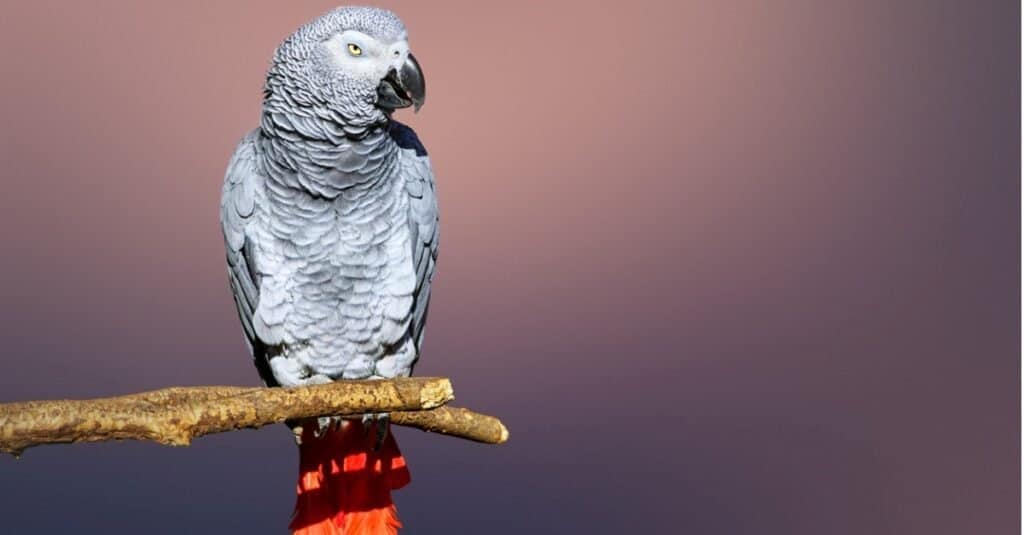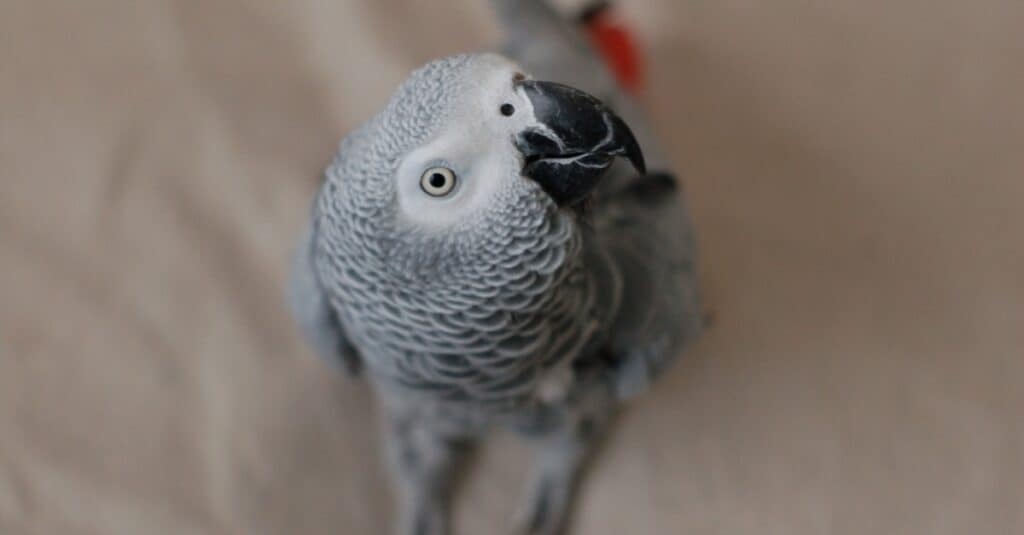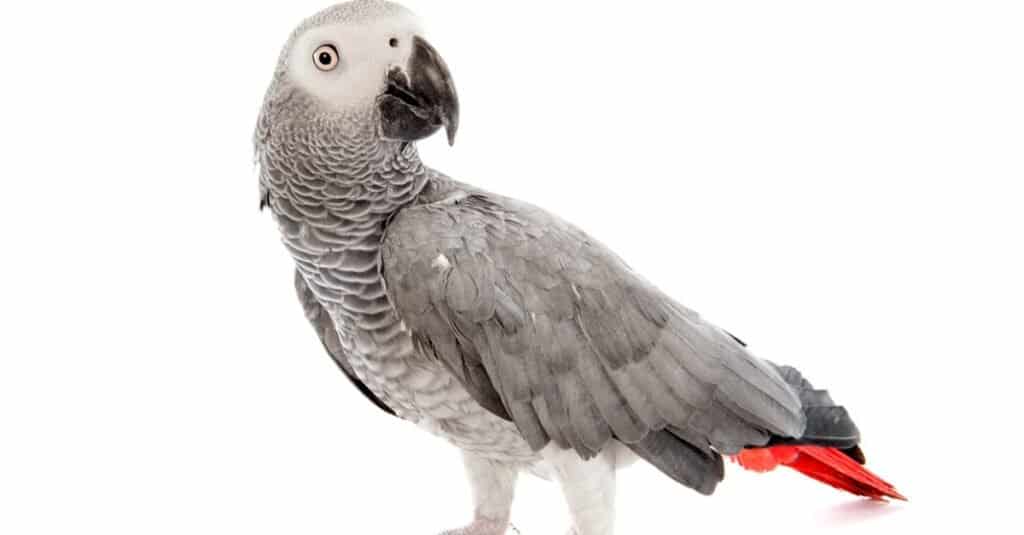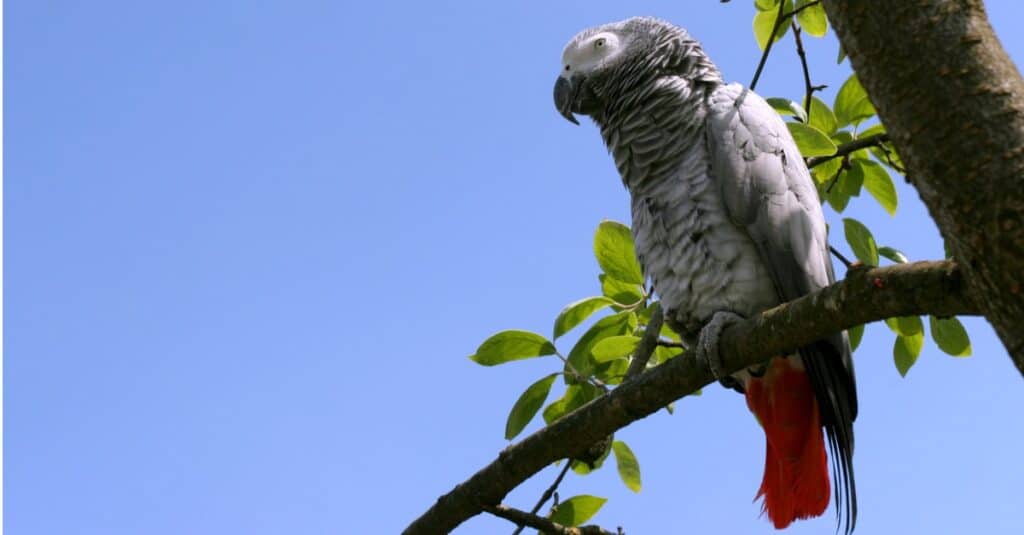The African Grey Parrot, also known as the Congo grey parrot, Congo African grey parrot, and the grey parrot (Psittacus erithacus), is a species of parrot native to the Old World (Psittacidae). The Timneh parrot, or Psittacus timneh, was formerly considered a subspecies of the grey parrot but is now recognized as its own species. The African grey parrot is native to the countries of Africa that are near the equator, which make up Equatorial Africa. This group of countries includes Angola, Cameroon, Congo, Gabon, Ghana, Ivory Coast, Kenya, and Uganda. Want to learn more about this fascinating bird? Keep reading to discover 10 incredible African Grey Parrot facts!

1. African Grey Parrots Are Highly Social Birds

African grey parrots are extremely sociable animals that can live in groups of up to 50.
©iStock.com/n1kcy
The majority of African grey parrots are extremely sociable. They have large, multigenerational broods that allow for unfettered interaction between the young and old. Their daily lives include a significant amount of socialization and vocalization.
They are kind to one another in the wild, get along well with their owners, and make good companions. African grey parrots are extremely sociable animals that can live in groups of up to 50.
2. African Grey Parrots Can Be Territorial

A contented, healthy African grey parrot poses no threat to you.
©Etienne Outram/Shutterstock.com
In captivity, things can be a little bit different. African grey parrots are territorial because they have a small area, and they could dislike living with other birds or act unduly protective of “their” food and toys.
Additionally, they need a lot of stimulation and attention because they are intelligent beings, and they may become unruly around their owners if they don’t get it. A really disgruntled or bored bird can even attack you.
A contented, healthy African grey parrot poses no threat to you. They could cause issues if mistreated, just like any other creature might, but if you raise them properly, they might become lovely friends.
3. They Have Many Shades of Grey

The beak and eyes of the African grey parrot are black.
©iStock.com/Lilly Nonamaker
The African grey parrot’s plumage has more hues and complexities than you may expect, even though it appears to be a monochromatic bird. It’s not a solid grey, for instance, and its undercoat feathers are a lighter, more silvery grey than its head and wing feathers, which are a darker grey.
There are a few additional colorful accents. Additionally, striped and white-tinged are the feathers on the head. The African grey parrot’s beak and eyes are black, with bright red tail feathers. The parrots may occasionally develop red, blue, brown, or albino mutations.
4. African Grey Parrots Are Sometimes Called by Other Names

The Congo grey parrot is another name for the African grey parrot.
©cynoclub/Shutterstock.com
It’s common to refer to it simply as a “grey parrot,” but it’s important to specify which breed you’re referring to because this phrase can also be used to describe Timneh grey parrots. The Congo grey parrot is another name for the African grey parrot.
As an aside, the Timneh parrot is currently considered a separate species. It is also referred to as the Timneh African or Grey Parrot, and the abbreviation TAG is sometimes used to refer to it.
5. They Are Considered “Old World” Birds

Old World parrots are native to Africa and Asia, while New World parrots are found in the Americas.
©iStock.com/surachetsh
If ornithology is new to you, you might be curious as to why some species are referred to as “Old World” parrots while others are referred to as “New World” parrots. There are some parallels between the two, but there are also significant distinctions; Old World parrots are native to Africa and Asia, while New World parrots are found in the Americas.
Old World parrots are adapted to surviving in hot, dry environments (Africa). Wet, humid jungles are ideal for New World parrots (the Amazon). Because their species have evolved to various settings, Old World parrots produce more bird dust than New World parrots. Sadly, they are more prone to fatal avian diseases such as Proventricular Dilatation Disease (PDD).
6. African Grey Parrots Can Talk

African grey parrots mimic human speech, and research shows they understand what they are saying.
©avers/Shutterstock.com
In addition to mimicking human speech, they can also be taught to respond to queries, show affection, and apply techniques like logical reasoning. According to certain research, they have the same intelligence as a kindergartener!
For training purposes, they can be taught specific words and phrases, or they can gradually learn sounds from their environment. African grey parrots frequently astound their owners with TV jingles that they have picked up.
7. They Can Understand What They Are Saying

African grey parrots can learn, remember, analyze, and share information when it is pertinent to them.
©iStock.com/AJevs
Some may contend that parrots can only mimic human speech without understanding its meaning. However, these individuals are unfamiliar with parrots. The exceptionally intelligent African grey parrot is a prime example of this. According to all available evidence, they can learn, remember, analyze, and share information when it is pertinent to them.
8. African Grey Parrots Are Incredibly Smart

The African Grey Parrot can learn around 1,000 words.
©iStock.com/Adrian Black
They are said to have brain development comparable to children between the ages of 3 and 6! The intellect of African grey parrots is among their most unique characteristics, and there is a long list of outstanding abilities possessed by African grey parrots.
They can imitate human speech, recognize shapes and colors, understand number sequences, ask questions without being asked, and carry on lengthy conversations with their owners. They are even capable of using probabilistic reasoning and deductive logic. In terms of intelligence, these parrots are right up there with dolphins and gorillas.
9. African Grey Parrots Mostly Fly At Low Levels

African grey parrots frequently nest in trees above lakes and rivers.
©Watchara Manusnanta/Shutterstock.com
These parrots prefer tall, dense forests, but they have also been seen in clearings and on the borders of forests. Their typical habitat is low canopies, and their greatest known elevation is 2,200 feet. They tend to favor water over other substances and frequently nest in trees that are situated above lakes and rivers.
10. Parrots Climb More and Fly Less Than Most Other Birds

African grey parrots can fly but prefer to climb and perch.
©fiz_zero/Shutterstock.com
Though they can fly, African grey parrots don’t always do it as frequently as other birds. For instance, they travel across tree canopies using their beaks and claws instead of flying from branch to branch. If you’re considering getting a parrot as a pet, make sure you get something bigger so she has room to fly around and climb, especially when you’re not home.
Related Animals:
The photo featured at the top of this post is © egotripone/Shutterstock.com
Sources
- Wikipedia, Available here: https://en.wikipedia.org/wiki/Grey_parrot
- National Geographic, Available here: https://www.nationalgeographic.com/animals/birds/facts/african-gray-parrot
- Britannica, Available here: https://www.britannica.com/animal/African-gray-parrot
Thank you for reading! Have some feedback for us? Contact the AZ Animals editorial team.






